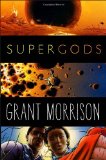What can Superheroes and Gods, at least those commonly depicted in comics and graphic novels, teach us about being human? Grant Morrison has some insights.
Grant Morrison is perhaps best known as the writer of some popular comics, such as comics depicting the X-Men, Batman, the Fantastic Four, and Superman, among many others. He is a comic industry veteran and his thoughts carry much influence. Thus, Morrison’s combined accounting and history of the comic industry, along with his own memoir, Supergods: What Masked Vigilantes, Miraculous Mutants, and a Sun God from Smallville Can Teach Us About Being Human, presents a welcome accounting of comicbooks as well as an interesting look into the mind behind one of comic’s most well-known writers.
Part 1 surveys the Golden Age of comics, where comics as in industry took off. Morrison focuses on the two superhero pillars of this age, Superman and Batman, though other superheroes make their mention. The Golden Age ends when comics infiltrate popular culture enough that government officials launch “moral standards” meant to keep comics from currupting the youth.
In Part 2, the Silver Age, Morrison details how the 1950s-era comics evolved to explore psychological flaws and weaknesses in the superheroes, such as Superman’s fear of commitment. Here the role-model aspect of superheroes developed, since readers could relate to emotional tramas and insecurities, even as their heroes defied death and smashed worlds with their fists.
The Dark Age, Part 3, follows the invasion of British comicbook writers into the US comic scene, resulting in heralded comics such as Arkham Asylum (Morrison), The Sandman (Gaiman), and Watchmen (Moore).
The last part, The Rennaissance, turns more inward, exploring more of Morrison’s philosophical musings on the fifth dimension as well as details from his personal life, such as his possible drug use, cross-dressing, and dabblings in the occult.
The tone of the writing is conversational, though at times trippy and almost stream-of-conscious. When Morrison tells of his drug experimentations, the reader can better understand Morrison’s sometimes overly psychodelic passages and narrative meanderings.
This book is both a satisfying history of comics and the comic industry from an insider’s perspective as well as a glimpse into Morrisson’s own philosophical musings and life history.
I enjoyed the book. Still, the length of the book and the meandering, trippy fusing of comicbook industry history with his own memoir and acid-trip visions, suggest that Morrison could have divided the book into two, in order to keep the focus on each main topic—comic industry and Morrison memoir—more clear.
Nevertheless, Supergods has much to say about comics, superheroes, role models, and what really makes us human. Despite all their valor, strength, and other-worldly abilities, our comic heroes have weaknesses. It is precisely those weaknesses that make them role models for humans, for we all sometimes fail. But heroes get back up. And that gives us something to strive for.
Morrison, in his book, says this as only he can, and I’m glad he did.
